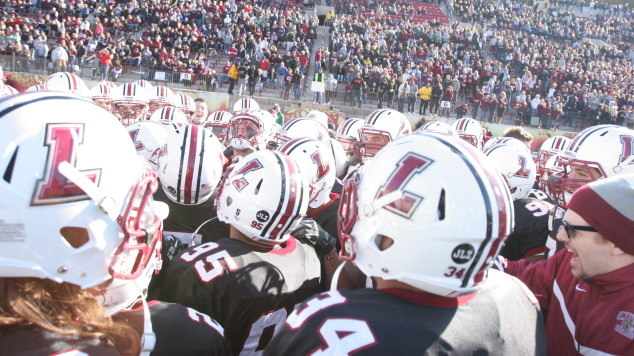NCAA Redesign Could Prove Costly To Conferences Like Patriot League

By Chuck Burton
Publisher/Managing Editor
College Sports Journal
BETHLEHEM, PA. — There are a lot of microphones, as well as media members, at the media days of the Big Ten, Big XII, Pac 12, SEC, and ACC.
Judging by that alone, you might get the impression that the only voices that matter in regards to new governance changes in the NCAA are the commissioners and athletic directory of the so-called “Power Five”.
At Patriot League media day in Bethlehem, Pennsylvania, the theme, as articulated by Patriot League executive director Carolyn Schlie Femovich, seemed to be about the league experiencing a challenging, expensive renovation of the NCAA structure surrounding their college athletics.
“It seems certain,” Femovich said in her opening remarks, “that we are going to enter into a redesigned governance structure that will give the five major BCS conferences some autonomy in making decisions in key areas about how they use their resources, how they support their student-athletes, and how they manage their programs.”
“The fallout or effect of that is difficult to say,” she continued, “but I think for the Patriot League it’s not going to change much how we do business. Whatever we do philosophically will not change, but I think the external world will challenge us in a lot of different ways.”
Femovich talked about the power conferences’ plan to implement governance changes as an NCAA “redesign” in order to allow those schools to have more control over their own destiny, something she felt that would almost certainly be endorsed a little more than a week from now.
She was quick to mention, though, that it wouldn’t be the end of the story.
“How it plays out will depend on exactly how they decide to use that autonomy,” she said. “There may be some areas where those 65 schools agree, but they are not unanimous. I think it really depends on what they think is important and how they go forward with their own destiny.”
For the Power 5, the costs of an NCAA “redesign” might seem like a team of interior designers ripping up the second bathroom on the third floor of their mansion.
For smaller conferences like the Patriot League, however, the hope is that it’s more like “redesign on a dime”.
While Femovich couldn’t say for sure if the “Power 5″‘s autonomy proposal would bring changes to add “full cost of attendance” to the values of scholarships – the authority to add increased amounts of money to the values of scholarships to cover buying books and other essential items and services – the league’s discussions clearly were preparing for that expensive contingency.
If the “Power 5” implements “full cost of attendance”, individual conferences from the so-called “Group of Five” – the American Athletic Conference, Mountain West, MAC, Sun Belt, and Conference USA – will have a choice to make on a conference-by-conference basis whether they want to allow their schools to offer it as well.
This directly affects two Patriot League schools – Army and Navy, who compete as FBS independents in football.
When Navy will be joins the AAC in 2015, they may have to option to implement “full cost of attendance” scholarships for football. And if Congress allows them to appropriate funds for this purpose, equal opportunity will need to be offered to women’s sports as well, directly affecting all Patriot League sports.
“There are a lot of dynamics here, lots of tentacles,” she told me. “We will feel the pressure in all sports, not just football.”
Femovich sees college athletics as a “competitive marketplace”, where the Patriot League competes with all conferences, not just other league members, for athletes. For her, it’s not a matter of flipping houses – it’s sticking with the league philosophy that has served the league well since it’s inception.
“It’s never been our issue in terms of how we manage our programs,” she said. “We may not do things the way everybody else does, from academics or whatever we do. Our philosophy grounds us. But [full cost of attendance] will put pressure on everybody. I just think that five years from now college athletics are going to look a lot different than they do today.”
One thing she did not think would happen was schools starting considering athletes as paid employees of the schools.
“We’re not paying athletes,” she said. “Nobody wants to go there.”
Instead, she focused on something that is sometimes lost among the cameras at the SEC and Big 10 media days: amateurism.
To Femovich, the biggest question in regards to the potential NCAA governance chages is the status of what it means to be an amateur athlete.
“How do you preserve the athletic part of the educational experience?” she said. “How do you think about the health and well-being of your student-athletes? What is appropriate for them as amateur athletes?”
“We all want to preserve this amateur model,” she continued. “But the more money you have in the game, and the more money you have to spend, the less it looks like amateurism. That’s the pressure at the upper level. How you define amateur athlete at that point?”
So many questions. So many pressures. So many directions these debates on amateurism, full cost of attendance, and autonomy can still go.
And yet, only one conclusion could be reached at Patriot League media day.
“I think this will be a defining moment in college athletics,” Femovich said.
That’s something that everyone can agree upon regardless of household budget.
